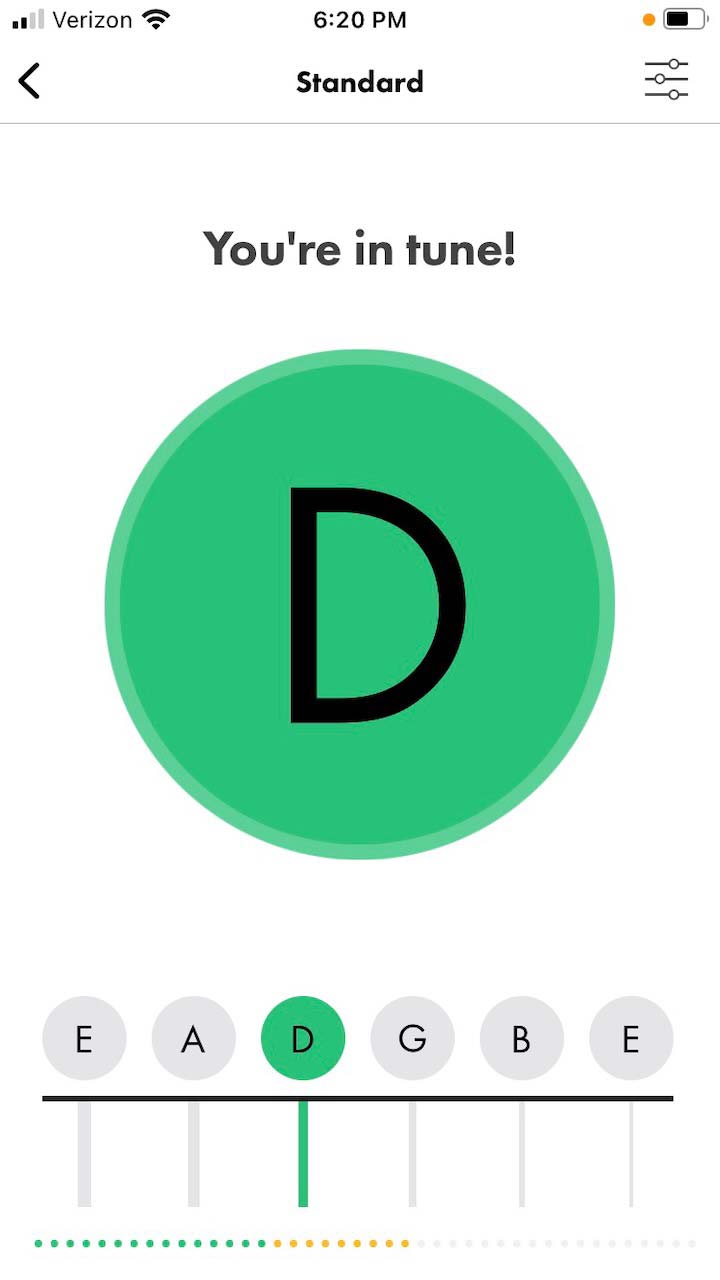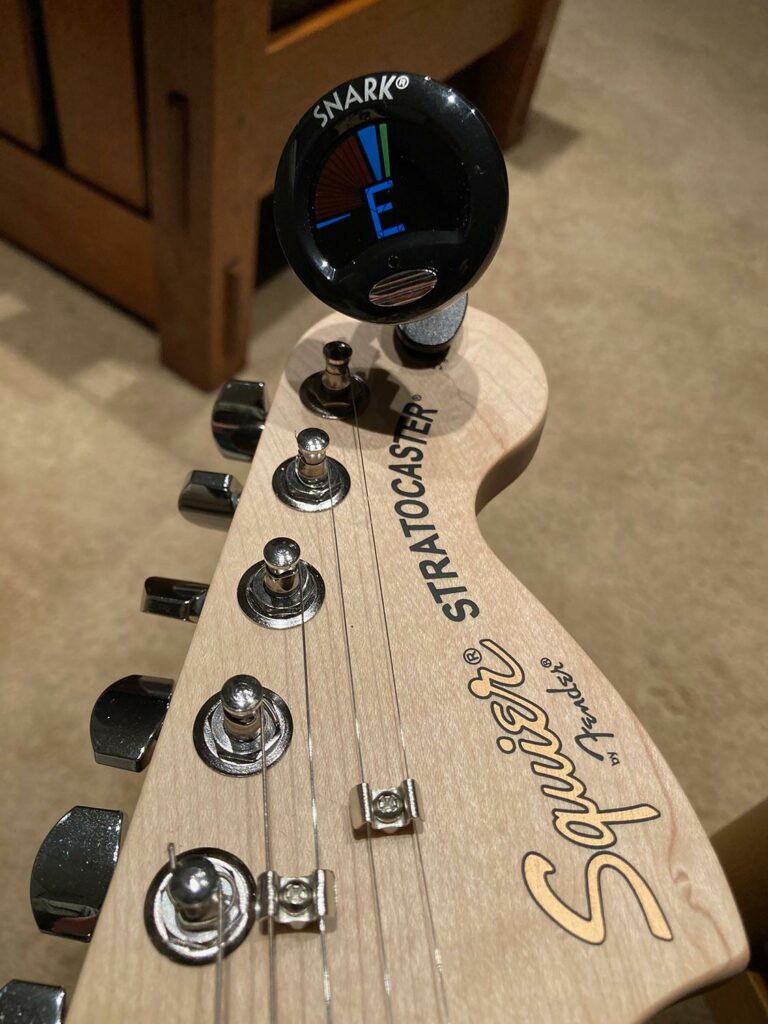Guitar River is reader-supported. We may earn a commission when you make a purchase using the links on our site.
Learn more.
Guitar Tuning Mysteries Solved: Best Ways To Tune Your Electric Guitar

As a beginner guitar player, tuning your guitar may be a complete mystery. Luckily, this is a skill you can easily learn. With some practice, keeping your guitar in tune will become second nature and a simple task you can do quickly before your practice sessions.
There are a few different ways to tune a guitar, and your method will depend on what you have available. For example, you can tune a guitar with an app, an electronic tuner, a tuning fork or pitch pipe, or even tune by ear with a piano or another guitar.
In this blog post, we’ll walk you through how to tune a guitar using these methods. We’ll also look at some basics, such as standard and alternate tunings. By the end of the article, you’ll be a pro at getting your guitar in tune!
Table of Contents
- The Tuning Of The Guitar
- Tuning Your Guitar With An App
- Tuning Your Guitar With An Electronic Tuner
- Tuning A Guitar Without A Tuner
- How To Tune Your Guitar Without A Tuner
- Tuning A Guitar With A Tuning Fork
- Tuning A Guitar With A Pitch Pipe
- Tuning A Guitar With An Amp Or Audio Interface
- Tips for Keeping Your Guitar in Tune
- Frequently Asked Questions
The Tuning of the Guitar
The most common tuning of a guitar is E, A, D, G, B, and E, which denotes the pitch of the strings from low to high. This is referred to as standard tuning.
The intervals between most of the strings is a perfect fourth. The exception is the interval between the second and third strings, which is a major third. This is a quirk of tradition; inherited from earlier stringed instruments.
Standard tuning is the best place to start as a beginning guitar player. As you gain experience, you can begin to experiment with alternate tunings. You will find alternate tunings for folk and acoustic music, for example, and for metal.
Tuning Your Guitar With An App
Perhaps the easiest way to tune your guitar in our modern age is to use an app on your smartphone or tablet. There are a few different apps available that will help with the process.
Fender Tune
My favorite guitar tuner app is the Fender Tune app. It’s free and straightforward to use. There is a Pro Tuner within the app with some additional features, but the free tuner will work fine.
Within the app, there are both auto and manual tuners. The easiest to use is the auto tuner. It listens for your guitar and gives you an indication of what note is being played and whether it’s in tune or not.
You have the option of playing a reference pitch as well. This is handy if your guitar is very out of tune or if you are changing strings.
After selecting the auto tuner, pluck the string you want to tune. The app determines the string being played and whether it’s sharp or flat. Use the tuning keys on your guitar to adjust the string pitch until the app shows you are in tune.
The manual tuner is handy if you want to tune by ear. This will play a reference tone and sustain the note as if the open guitar string was plucked. From there, tune your guitar to match the pitch from the app.
The Fender Tune app will play a success tone once your string is in tune. I find it useful, but you can turn this off in the app settings as needed.


GuitarTuna
Another option is the GuitarTuna app by Yousician. The basic version is free, with optional in-app upgrades. Similar to Fender Tune, GuitarTuna includes both a manual and an auto tuner.
With a Yousician account, you can access a few other features that may be helpful, such as a metronome and lessons.
Other Guitar Apps
Apps that you may already be using have a tuner as well. For example, both AmpliTube and GarageBand have tuners built-in. You may not even need to download another app.
No matter which app you use, tuning your guitar with an app is a quick and easy way to get your instrument in tune.
Tuning Your Guitar With An Electronic Tuner
Stand-alone electronic tuners are another effective way to tune a guitar. These are available in different formats, including clip-on, pedal, and handheld tuners. You can even find wearable guitar tuners!
Clip-on Guitar Tuner
Clip-on guitar tuners are easy to use, affordable, and relatively accurate. For those reasons, clip-on tuners are the most popular type of guitar tuner.
As the name suggests, a clip-on tuner attaches to your guitar. These are designed to clip onto your guitar’s headstock. The tuner picks up the vibration of the guitar string and displays whether or not it is in tune.
It’s easy to use, and you can get a basic clip-on tuner for under $20. More expensive options will have bright LED displays and additional capabilities. The LED display is handy as the inexpensive clip-on tuners are sometimes hard to see.

Pedal Tuner
Pedal tuners are designed to be integrated into your guitar pedal board. Pedal tuners have a screen or another indicator built into the pedal. When activated, a pedal tuner works just like a regular guitar tuner.
These are convenient in a performance setting and can be activated without attaching anything to your guitar or plugging in a handheld guitar tuner.
Handheld Guitar Tuner
A handheld guitar tuner is a standard piece of equipment that you plug directly into with your guitar cable. These can also have a small microphone for use with acoustic guitars. Some will include a speaker to produce a reference tone.
Handheld tuners were the most popular option before clip-on guitar tuners and apps arrived on the scene. They can still be helpful; some have additional features such as the Boss TU-30 Metronome and Tuner.
Handheld tuners are convenient for home practice and acoustic guitars. If you can’t stand using apps, or have a vintage finish on your headstock and don’t want to use a clip-on tuner, give a hand-held tuner a try.
Wearable
A wearable guitar tuner may be a misnomer. The Soundbrenner Musician’s Smartwatch has features for musicians such as a metronome, decibel meter, and tuner.
It can be removed from the watchband and connected to your guitar, where it functions as a standard tuner with a piezo contact sensor.
The smartwatch tuner might be helpful to you if you want to use the other features of the watch. The vibrating metronome might be the most innovative feature of the watch. We suggest getting a standard clip-on tuner if you don’t need that.
Rackmount and Desktop
In a studio setting, desktop and rackmount tuners may be used. Mechanical strobe tuners are more precise than their digital counterparts. They use a rotating disc and strobe light to match the frequency of your instrument. Once the disc appears stationary, your guitar is in tune.
A rackmount tuner can be used on stage to quickly and easily check your tuning with a large LED display. This style of tuner is also used in a studio setting where an audio engineer may already have an extensive collection of rackmount boxes.
Tuning A Guitar Without A Tuner
What happens when you don’t have a tuner handy? Well, there are a few ways to tune your guitar without a tuner. These include:
- Tuning a guitar by ear
- Tuning the guitar to itself
- Tuning a guitar with a tuning fork or pitch pipe
- Tuning a guitar using another instrument like a piano
Note that all of these techniques are basically tuning the guitar by ear. Instead of relying on an app or electronic tuner, you must listen carefully and match your guitar’s tone to the reference note.
How To Tune Your Guitar Without A Tuner
To tune your guitar by ear, we need to remember the guitar’s tuning.
Remember that interval between the guitar strings is a perfect fourth, except for the second and third strings. That interval is a major third.
This is important because it relates to the technique you use to tune your guitar.
The standard method of tuning your guitar by ear is to play the note at the fifth fret, and then play the following open string. These two notes should sound the same. When they do, those strings are in tune with each other.
The exception is the second and third strings. Because of the guitar’s unique tuning, you need to play the note on the fourth fret of the third string to tune the second string.
I know, it sounds weird. But trust me, it’s easy once you get the hang of it. Here is a step-by-step process of getting your guitar in tune without a tuner.
- Step 1, tune the low E string.
Ideally, your low E string needs to be in tune. If you don’t have a tuner or a reference note, you can at least tune your guitar to itself. You will be in tune but may not be precisely on pitch.
Pro Tip: If you play guitar often enough, you can probably approximate what an E should sound like. You can even think of songs that you know are in the key of E and use that as a reference pitch. Many classic Metallica songs use standard tuning and are in the key of E. Think of the opening to “Welcome Home (Sanitarium),” and you have your E reference pitch.
- Step 2, tune the A string.
Tune the A string by playing the A note at the fifth fret of the E string. Place your index finger on the fifth fret of the E string, pluck the note, and let it sustain or ring out. While the note is sounding, pluck the open A string. The two notes should sound the same. Adjust the pitch of the A string to match the same note being played on the E string.
Pro Tip: When the two strings are out of tune, you might hear a slight wavering or oscillation between the notes. As the strings get closer to being in tune, the wavering will stop, and the notes will sound unified.
- Step 3, tune the D string.
Next, tune the D string using the same method. Fret the D note on the fifth fret of the A string. Let it sound out and pluck the D string. Adjust the tuning key for the D string until the notes sound the same.
Pro Tip: Tune up into the note instead of tuning down. In other words, tune from a flat note to the correct pitch. It’s better to tune up as this will help keep tension on the string and help keep your guitar in tune. - Step 4, tune the G string.
At this point, you should be a pro at tuning by ear! Follow the same approach for the G string. Fret the G note on the fifth fret of the D string, and tune the G string so that it matches the tone.
Pro Tip: You can also use harmonics to tune. If you know how to play a harmonic, use the harmonics on the fifth fret and seventh fret of the next string. You may be able to hear the oscillation better between out-of-tune notes using harmonics. - Step 5, tune the B string.
If you remember the guitar’s tuning discussed above, you’ll know this string is a special case. Instead of fretting the note at the fifth fret, go ahead and fret the B note at the fourth fret of the G string. Play this note and the B string, then adjust the B string to match.
Pro Tip: Since this string is a unique case, you’ll need to play harmonics at the fourth and fifth frets instead of the fifth and seventh frets. The harmonic at the fourth fret of the G string can be very difficult to trigger.
- Step 6, tune the high E string.
You’ve made it! All that remains is to tune the first string or the high E string. For this one, you will need to tune it as with the A, D, and G strings. Fret the E note on the fifth fret of the B string and play the note. Pluck the open E string and tune it to match the pitch.
Pro Tip: Check both E strings at this point to see if they are in tune. Play both the first and sixth strings together and see if they match. If they don’t, repeat the process until all strings are in tune.
Tune Your Guitar With a Tuning Fork
Even though apps and electronic tuners are the easiest way to tune your guitar, you can still use a tuning fork or pitch pipe to tune your guitar.
A tuning fork is a tool primarily used to tune musical instruments. It consists of a metal rod, bent in the middle to form a “fork” shape.
When the tuning fork is struck against an object or with a mallet, it creates a precise tone. The tone can be more easily heard by placing the tuning fork against a soundboard. Tuning forks are calibrated to specific pitches, such as A or 440 Hz.
Though these low-tech devices are more often used when tuning a piano, one could still match the pitch of a tuning fork when tuning a guitar by ear.
Tune Your Guitar Using a Pitch Pipe
A pitch pipe is a small, hand-held device mainly used by vocalists to establish the correct pitch before singing.
A pitch pipe is often a round disc with multiple openings corresponding to specific notes. By blowing into one of the openings, the pipe produces a sound at the designated pitch.
There are even guitar-specific pitch pipes with the notes of the guitar’s standard tuning: E, A, D, G, B, and E.
Tuning a guitar with a pitch pipe is the same process as tuning without a tuner. Just use the pitch pipe as a reference note.
Start by blowing into the pitch pipe using the note corresponding to the string you want to tune. Use your tuning key to adjust the string until it is in tune with the note that the pitch pipe is producing.
Move on to the next string and repeat the process until all strings are in tune.
Tune Your Guitar With An Amp Or Audio Interface
Finally, if you own a practice amp such as the Blackstar ID:CORE 10 V2 or V3, you will have a guitar tuner built into the amplifier. Using your amp to tune up before a practice session is convenient, and you can skip fiddling with a clip-on tuner.
Check your amp for the specifics, but when in tuning mode, you should see red and green lights indicating whether you are in tune or not. If it’s green, your string is in tune, and a red light above or below the green light will tell you if the note is sharp or flat, respectively.
I sometimes combine a clip-on tuner with the tuner in my Spark amp for extra accuracy.
If you connect your guitar to your computer through an audio interface, you might also have a tuner available there. For example, The AXE I/O has a tuner built into the front of the interface.
This makes it easy to check your tuning before a recording session.
Tips for Keeping Your Guitar in Tune
Once you have your guitar tuned, you’ll want to do what you can to keep it in tune. Here are a few tips:
- Avoid making drastic changes to the tuning of your guitar. If you’re playing a different type of music that requires an alternate tuning, your guitar may need time to fully adjust to the new tuning. Alternately, you can tune a second guitar to a different tuning.
- When changing strings, gently stretch the guitar strings to keep them in tune. When you first put new strings on your guitar, they can go out of tune more often at first. As they settle in, they will stretch less and stay in tune better. Check out our complete guide on how to keep your guitar in tune for an overview.
- Clean your strings regularly. Guitar strings tend to get dirty and corrode from the oils on your hands over time. Older strings sound a little flat and are sometimes difficult to keep in tune. You can prolong their useful life by cleaning your strings after you play.
- Keep an eye on the humidity. Changes in humidity can affect your guitar in many ways and wreak havoc on the tuning of your guitar. By keeping your guitar at a consistent humidity level, you will also keep your guitar in tune better.
By following these tips, you’ll be able to keep your guitar in tune and sounding great for a long time to come!
Frequently Asked Questions
Where Do I Place The Tuner On The Guitar?
Your clip-on tuner should be attached to the headstock of your guitar. From there, it will detect the vibrations of the guitar strings, and you can see it clearly while you adjust the tuning keys.
How Often Should I Tune My Guitar?
A good habit is to tune your guitar each time you practice. This will help keep it in tune. And making minor adjustments each time you play is more manageable than starting from scratch after letting your guitar go out of tune.
Why Do Guitars Go Out Of Tune?
If you’re having issues with your guitar going out of tune, check out our tips on how to keep your guitar in tune. You can do a few things each time you change the strings that will set yourself up right and help keep your guitar in tune.
Wrapping Up
There are multiple ways to tune your electric guitar. The easiest way is to use an app or a clip-on tuner. You can try a handheld, pedal, or desktop tuner for more precise tuning. For an analog backup, an inexpensive pitch pipe is a good option.
No matter how you decide to tune your guitar, it is an essential skill you should learn as a guitar player. It’s easy to do and will make your music sound much sweeter.



